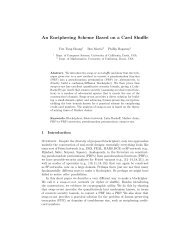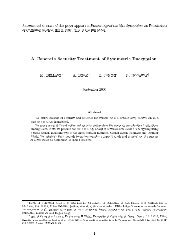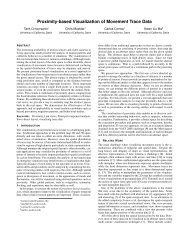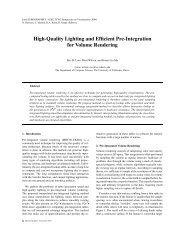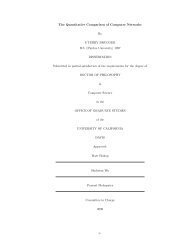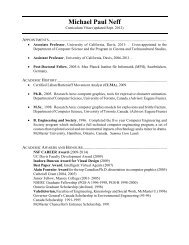Homework Assignment #2
Homework Assignment #2
Homework Assignment #2
Create successful ePaper yourself
Turn your PDF publications into a flip-book with our unique Google optimized e-Paper software.
Problem One (1.6.4)<br />
<strong>Homework</strong> <strong>Assignment</strong> #3<br />
Suppose that A={2, 4, 6}, B={2, 6}, C={4, 6}, and D={4, 6, 8}. Determine which of these sets are subsets of which other of<br />
these sets.<br />
Every set is a subset of itself B is a subset of A C is a subset of both A and D.<br />
Problem Two (1.6.14)<br />
What is the cardinality of each of these sets?<br />
a) ∅ 0<br />
b) {∅} 1<br />
c) {∅, {∅}} 2<br />
d) {∅, {∅}, {∅, {∅}}} 3<br />
Problem Three (1.6.16)<br />
Can you conclude that A = B if A and B are two sets with the same power set?<br />
Yes. By definition, P(A) is the set of all subsets that can be generated from A, if A and B generate the exact same collection<br />
of valid subsets, then it must be that A and B contain the same elements and are therefore equal.<br />
Problem Four (1.6.20)<br />
What is the Cartesian product A cross B, where A is the set of courses offered by the mathematics department at a<br />
university and B is the set of mathematics professors at this univers ity ?<br />
It is the set of all possible combinations of math courses and possible instructors.<br />
Problem Five (1.7.4)<br />
Let A={a, b, c, d, e} and B={a, b, c, d, e, f,<br />
g, h}. Find<br />
a) A ∪ B {a, b, c, d, e, f, g, h}<br />
b) A ∩ B {a, b, c, d, e}<br />
c) A – B { }<br />
d) B – A {f, g, h}<br />
Problem Six (1.7.16)<br />
Show that, i f A and B are sets, then (A ∩ B) ∪ (A ∩ BC) = A. [Note: BC is another way of writing the complement of set B]<br />
There are two ways of solving set proofs like these, one is to look at an arbitrary point and use the properties of sets to<br />
argue why something it true. The other way to do this is to notice that a set is nothing but a collection of elements, and<br />
that collection of elements will be the truth set for some proposition. Therefore, if we can prove that the truth sets on<br />
either side of the equation are equal, then the sets they represent must also be equal. Both proof forms are provided as a<br />
solution. Note that, while the proposition-style proof is inherently longer, it is often far more formulaic in its construction<br />
and therefore easier to write and, usually, understand.<br />
Set-style Proof<br />
Note that every point a, in A, is an element of either A ∩ B (in the case that a∈B) or an element of A ∩ BC (in the case that<br />
a∈BC). Also, if a∈(A ∩ B) ∪ (A ∩ BC), then either a∈A ∩ B or a∈ ∩ BC, in either of these cases, a∈A by the definition of<br />
intersection, so it must be that (A ∩ B) ∪ (A ∩ BC) = A.<br />
Proposition-style Proof<br />
Let p(x) be the proposition whose truth set is the set A<br />
Let q(x) be the proposition whose truth set is B
[01] A = x∈U, p(x) By definition<br />
[02] B = x∈U, q(x) By definition<br />
[03] (A ∩ B) = x∈U, p(x) ∧ q(x) By [01] and [02]<br />
[04] B C = x∈U, ~q(x) By definition<br />
[05] (A ∩ B C) = x∈U, p(x) ∧ ~q(x) By [01] and [04]<br />
[06] (A ∩ B) ∪ (A ∩ B C) = x∈U, (p(x) ∧ q(x)) ∨ (p(x) ∧ ~q(x)) By [03] and [05]<br />
[07] (A ∩ B) ∪ (A ∩ B C) = x∈U, p(x) ∧ (q(x) ∨ ~q(x)) By [06] and DeMorgan’s Law<br />
[08] (A ∩ B) ∪ (A ∩ B C) = x∈U, p(x) ∧ T By [07] and the Complement Law<br />
[09] (A ∩ B) ∪ (A ∩ B C) = x∈U, p(x) By [08] and the Identity Law<br />
[10] (A ∩ B) ∪ (A ∩ B C) = A By [01]<br />
Problem Seven (1.7.20)<br />
Draw the Venn diagrams for each of these combinations of the sets A, B, C.<br />
We assume for each of these, that the intersection of A, B, and C is non-empty. In each picture, the toned area represents<br />
the set in question.<br />
Problem Eight (1.7.22)<br />
a) A ∩ (B ∪ C) b) A C ∩ B C ∩ C C c) (A – B) ∪ (A – C) ∪ (B – C)<br />
Can you conclude that A=B if A, B, and C are sets such that<br />
a) A ∪ C = B ∪ C? No, this would be true if A and B are both subsets of C.<br />
b) A ∩ C = B ∩ C? No, consider the case when C is the empty set.<br />
Problem Nine (1.7.28)<br />
Show that A⊕B = (A – B) ∪ (B – A).<br />
Set-style Proof<br />
There are only two ways and element, x, can be in set A or set B, exclusive. It can be an element of A but not of B (in which<br />
case it is an element of the set A – B) or it can be an element of B but not of A (in which case it is an element of the set B –<br />
A). Therefore, an element, x, is in the set A⊕B only if it is also in the set (A – B) ∪ (B – A), so the two sides are equal.<br />
Proposition-style Proof<br />
Let p(x) be the proposition whose truth set is the set A<br />
Let q(x) be the proposition whose truth set is B<br />
Therefore, (A – B) ∪ (B – A) = x∈U, (p(x) ∧ ~q(x)) ∨ (q(x) ∧ ~p(x))<br />
[01] A = x∈U, p(x) By definition<br />
[02] B = x∈U, q(x) By definition<br />
[03] A⊕B = x∈U, ~(p(x) ∧ q(x)) ∧ (p(x) ∨ q(x)) By [01] and [02]<br />
[04] A⊕B = x∈U, (~p(x) ∨ ~q(x)) ∧ (p(x) ∨ q(x)) By [03] and DeMorgan’s Law<br />
[05] A⊕B = x∈U, [(~p(x) ∨ ~q(x)) ∧ p(x)] ∨ [(~p(x) ∨ ~q(x)) ∧ q(x)) By [04]and the Distributive Law<br />
[06] A⊕B = x∈U, [F ∨ (~q(x) ∧ p(x))] ∨ [(~p(x) ∧ q(x)) ∨ F] By [05] and the Distributive/Complement Law<br />
[07] A⊕B = x∈U, (~q(x) ∧ p(x)) ∨ (~p(x) ∧ q(x)) By [06] and the Complement Law<br />
[08] A⊕B = x∈U, (p(x) ∧ ~q(x)) ∨ (q(x) ∧ ~p(x)) By [07] and the Associative Law<br />
[09] A⊕B = (A – B) ∪ (B – A) By [08] and the definition above
Problem Ten (1.7.38)<br />
Let Aj = { … -2, -1, 0, 1, …, j}. Find<br />
n<br />
a) ∪ Aj<br />
j=1<br />
Each Aj is the set { … j}, so every Aj fully contains the sets Aj-1 Aj-2 etc. as subsets. Therefore, the union of the sets A1<br />
through An is exactly An. We can take this one step further and say that, since n is unbounded, An, in fact, is the set<br />
(-∞,∞).<br />
n<br />
b) ∩ Aj<br />
j=1<br />
Each Aj is the set { … j}, so every Aj fully contains the sets Aj-1 Aj-2 etc. as subsets. Therefore, the intersection of the sets A1<br />
through An is exactly A1 = {… -2, -1, 0, 1}.<br />
Problem Eleven (1.8.2)<br />
Note: the problem listed on the HW#3 handout was the wrong problem >.< Here is the correct problem (solutions to the<br />
incorrect problem appear below this one).<br />
Determine whether ƒ is a function from ℤ to ℝ if<br />
a) ƒ(n) = ∓n<br />
By definition, a function must map every point in its domain to a single point in the range. Since, for every n, there are two<br />
images, +n and –n, this is not a function.<br />
b) ƒ(n) = √(n2 + 1)<br />
Since ƒ(n) maps every point in the domain to some, single point in the range, this is a function.<br />
c) ƒ(n) = 1/(n2 – 4 )<br />
By definition, a function must map every point in its domain to some point in the range. Since the points x=2 and x=-2<br />
have no image in the range, this is not a function.<br />
Determine whether ƒ is a function from ℝ to ℝ if<br />
a) ƒ(x) = 1/x<br />
By definition, a function must map every point in its domain to some point in the range. Since the point x=0 has no image<br />
in the range, this is not a function.<br />
b) ƒ(x) = √(x)<br />
By definition, a function must map every point in its domain to some point in the range. Since no value less than 0 has an<br />
image in the range, this is not a function.<br />
c) ƒ(x) = ∓√(x2 + 1)<br />
By definition, a function must map every point in its domain to a single point in the range. Since, for every x, there are two<br />
images, this is not a function.<br />
Problem Twelve (1.8.12)<br />
Determine whether each of these functions from ℤ to ℤ is one-to-one<br />
a) ƒ(n) = n – 1 This function maps each value in ℤ to a unique image, therefore it is one-to-one.<br />
b) ƒ(n) = n2 + 1 The values 2 and -2 map to the same image in ℤ, therefore it is not one-to-one.<br />
c) ƒ(n) = n3 This function maps each value in ℤ to a unique image, therefore it is one-to-one.<br />
d) ƒ(n) = ⌈n/2⌉ The values 3 and 4 map to the same image in ℤ, therefore it is not one-to-one.
Problem Thirteen (1.8.18)<br />
Determine whether each of these functions is a bijection from ℝ to ℝ<br />
a) ƒ(x) = -3x + 4 This function is both one-to-one and onto, therefore it is a bijection.<br />
b) ƒ(x) = -3x 2 + 7 This function is neither one-to-one nor onto, therefore it is not a bijection.<br />
c) ƒ(x) = (x + 1)/(x + 2) This is not a function at all since it does not map the value -2.<br />
d) ƒ(x) = x 5 + 1 This function is both one-to-one and onto, therefore it is a bijection.<br />
Problem Fourteen (1.8.22)<br />
Let S={-1, 0, 2, 4, 7}. Find f(S) if:<br />
a) ƒ(x) = 1 f = {(-1, 1), (0, 1), (2, 1), (4, 1), (7,1)} f(S) = { 1 }<br />
b) ƒ(x) = 2x + 1 f = {(-1, -1), (0, 1), (2, 5), (4, 9), (7, 15)} f(S) = {-1, 1, 5, 9, 15}<br />
c) ƒ(x) = ⌈x/5⌉ f = {(-1, 0), (0, 0), (2, 1), (4, 1), (7, 2)} f(S) = {0, 1, 2}<br />
d) ƒ(x) = ⌊(x 2 + 1)/3⌋ f = {(-1, 0), (0, 0), (2, 1), (4, 5), (7, 16)} f(S) = {0, 1, 5, 16}<br />
Problem Fifteen (1.8.28)<br />
Find ƒog and goƒ where ƒ(x) = x 2 + 1 and g(x) = x + 2 are functions from ℝ to ℝ.<br />
ƒog = f(g(x)) = (x + 2) 2 + 1 = x 2 + 4x + 4 + 1 = x 2 + 4x + 5<br />
gof = g(f(x)) = (x 2 + 1) + 2 = x 2 + 3<br />
Problem Sixteen (1.8.32)<br />
Let f be a function from the set A to the set B. Let S and T be subsets of A. Show that<br />
a) f(S ∪ T) = f(S) ∪ f(T)<br />
Suppose we have a point b such that f(a) = b for some a ∈ (S ∪ T). Either a∈S and f(a) clearly belongs in f(S), or a∈T and<br />
clearly b belongs in f(T), either way, b∈f(S) ∪ f(T). This means that f(S ∪ T) ⊆ f(S) ∪ f(T) is true. Now assume there is a point<br />
b such that b∈(f(S) ∪ f(T)). This means that b is either a point in f(S) or b is a point in f(T), this means f has a pre-image<br />
(i.e., a point a such that f(a) = b) either in S or in T. In either case, b is an image for some point in (S ∪ T) and is therefore<br />
an element of f(S ∪ T). This means that f(S) ∪ f(T ⊆ f(S ∪ T). But if f(S ∪ T) ⊆ f(S) ∪ f(T) and f(S) ∪ f(T ⊆ f(S ∪ T), then it<br />
must be that f(S ∪ T) = f(S) ∪ f(T).<br />
b) f(S ∩ T) ⊆ f(S) ∩ f(T)<br />
Suppose we have a point b such that b∈ f(S ∩ T). Then b = f(a) for some a∈(S ∩ T). This implies that a∈S and a∈T, so we<br />
know that b∈f(S) and b∈f(T), so b must be an element of f(S) ∩ f(T) and we know that f(S ∩ T) ⊆ f(S) ∩ f(T).



